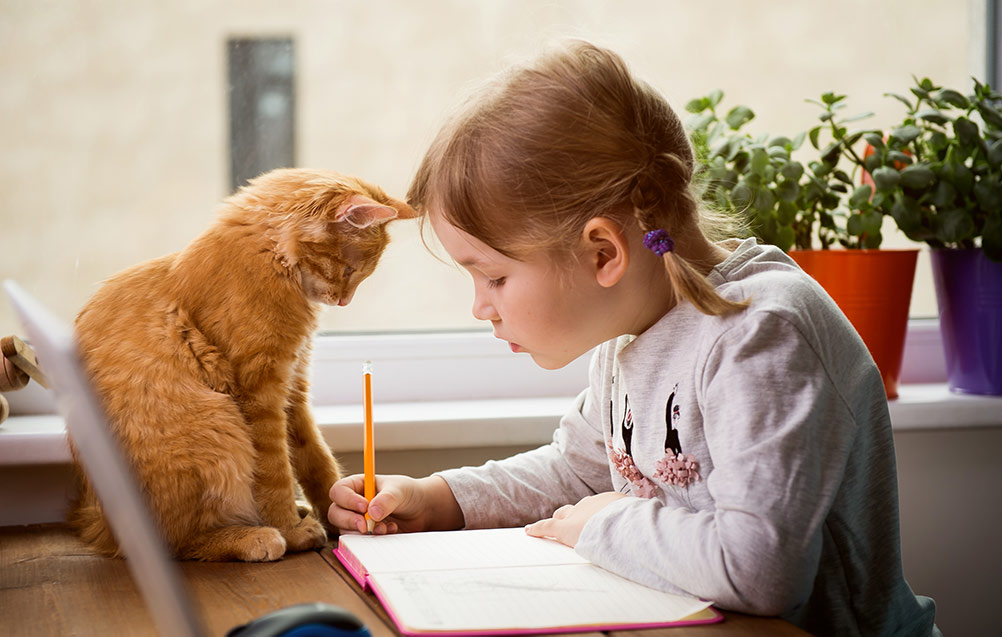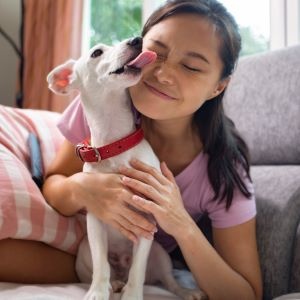Biliary tract disorder in cats
What is biliary tract disorder in cats?
The biliary tract refers to the organs and ducts in the abdomen that produce, store and secrete bile. These include the liver, gall bladder and bile ducts inside and outside the liver, which all work together in this process.
Bile is a yellow, brownish or olive-green fluid produced in the cells of the liver to assist in the digestion of fat. The gallbladder, located alongside the liver, stores and concentrates the bile. After fatty food is eaten, the gallbladder contracts and squeezes bile through the bile duct into the duodenum (the first segment of the small intestine) where it is mixed into the semi-digested food to help break down the fats.
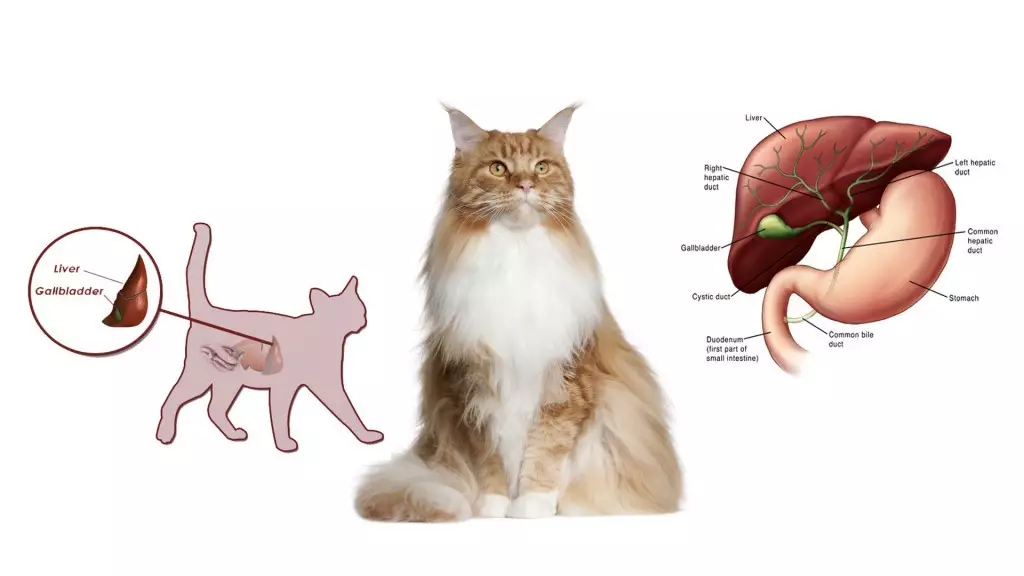
In cats, biliary tract disorder refers to a number of conditions affecting one or more of the organs or ducts of the biliary tract. The prefix “chol” appears frequently in the medical terminology relating to the biliary tract; it is of Greek origin, meaning “bile” or “gall”.
Some of the more common feline biliary tract disorders are:
Cholangitis/cholangiohepatitis syndrome
Cholangitis refers to inflammation of the bile duct. Cholangiohepatitis refers to inflammation of the bile ducts, gall bladder and surrounding liver tissue. Feline cholangitis/cholangiohepatitis syndrome (CCHS) is the most common acquired inflammatory liver disease in domestic cats, and occurs much more frequently than liver disease in dogs (Source). When the bile ducts are excessively swollen and inflamed, bile may not be able to enter the digestive tract, causing systemic problems. CCHS is therefore a serious condition that requires immediate medical attention.
Obstruction of the bile duct (cholestasis)
Obstruction of the bile duct prevents bile from moving from the gallbladder into the small intestine. An obstruction of the bile duct can result from a number of conditions, including gallstones that grow large enough to block the bile’s passageway, inflammation of the pancreas (pancreatitis), liver inflammation that prevents bile from entering the gall bladder, and bile duct tumours. Additionally, tissue swelling, inflammation, or scarring can cause compression of the bile duct. Cholestasis is a serious condition that needs to be treated promptly.
Inflammation of the gallbladder (cholecystitis)
The gallbladder can become inflamed as a result of bacterial infections, obstruction or inflammation of the bile duct or the liver and can even be caused by gallstones. The inflammation can spread from the gallbladder to the surrounding branches of the bile duct and the liver. Severe inflammation can lead to rupture of the gallbladder and subsequent severe inflammation of the bile duct, or bile peritonitis.
Gallstones (cholelithiasis)
Gallstones (choleliths) are stone-like structures that form in the gallbladder, typically comprised of calcium carbonate and other minerals and secreted substances. In cats, gallstones generally occur in conjunction with bile duct inflammation. Large stones are considered serious as they can block the release of bile and cause liver, kidney and digestive problems. Surgical removal may be necessary if gallbladder inflammation is present or if the stones are blocking the bile duct.
Rupture of the Gallbladder or bile duct
Rupture of the gallbladder or bile duct most frequently results from gallstones, inflammation of the gallbladder or blunt trauma. Rupture of the bile duct may also be caused by cancer or certain parasites. Rupture can lead to the leakage of bile into the abdomen, causing bile peritonitis, which may be fatal if the rupture is not repaired.
Symptoms of biliary tract disorder in cats
The symptoms of the various biliary tract disorders are fairly similar, as are the symptoms of some other metabolic diseases. Mild to moderate jaundice (a yellow tinge noticeable in the skin, mucous membranes, gums and eyes) is often the main sign of disorders of the gallbladder and bile duct.
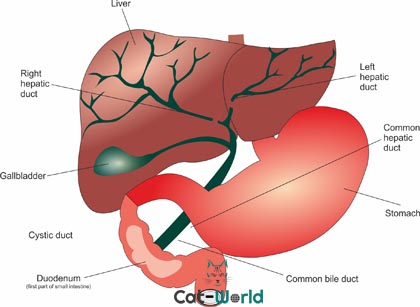
The cat may be exhibiting symptoms such as:
- Appetite changes, such as decreased appetite, sudden loss of appetite or sudden excessive appetite
- Vomiting
- Weight loss
- Abdominal pain
- Jaundice
- Lethargy
- Fever
- Pale stools
- Abnormal bleeding
- Shock (evident by shallow breathing, hypothermia, pale or grey gums, a weak but rapid pulse)
- Abdominal swelling (a swollen, palpable mass of tissue in the upper right abdomen)

Causes of biliary tract disorder in cats
While there are many factors that can cause biliary tract problems in cats, there is no direct association with breed, gender, or age.
Gallstones:
Inflammation, infection, a tumour or the shedding of cells in the gall bladder can lead to the formation of gallstones. While gallstones can be harmless, some are associated with problems within the gallbladder and bile ducts, such as:
- Causing inflammation that can facilitate the invasion of bacteria into the gall bladder.
- Travelling into the bile ducts and causing inflammation or complete or partial blockages of the ducts.
- Rupture of the gallbladder or bile duct, which leads to leakage of bile into the abdomen, possibly causing bile peritonitis.
Other conditions that can affect the organs and tissues of the biliary tract are:
- Bacterial infections originating in the intestine or bloodstream can invade the gallbladder and cause infection.
- Inflammation of the bile ducts can lead to failure of the bile to flow normally.
- Irritants in the bile can cause the bile duct to be overly sensitive and reactive.
- Muscles in the gall bladder can malfunction, which can lead to impaired bile flow in the cystic duct or gall bladder and irritation of the walls of the gallbladder.
- Cysts can lead to restricted blood supply to the gallbladder.
- A backward flow of pancreatic enzymes can trigger and intensify inflammation.
- Prior abdominal surgery or trauma to the abdomen can lead to internal sensitivity, affecting the liver and gallbladder.
- Parasites of the bile duct (biliary coccidiosis).
- Distension of the gallbladder from an inappropriate accumulation of mucus.
- Abnormal gall bladder development.
- Other diseases, including feline infectious peritonitis (FIP), feline leukemia virus (FeLV), toxoplasmosis and coccidiosis.
- Disorders of the liver, bladder, pancreas or intestines can disrupt the functioning of the bile ducts.
How is biliary tract disorder in cats diagnosed?
Diagnosis of a biliary tract disorder begins with a detailed history of the cat’s current symptoms as well as prior health conditions, which may provide a useful starting point for diagnosis, for example:
- Prior episodes of gallstones could indicate a recurrence and potential blockage.
- Previous abdominal surgery, especially any procedures involving the bladder, liver or small intestines might indicate fibrosis or adhesions.
- Exposure to other cats, especially those not vaccinated against FeLV or FIP, could be a risk factor.
The vet will then perform a physical examination and carry out diagnostic tests, such as:
- Blood tests, including a complete blood count to check for bacterial infection.
- Urinalysis
- Stool sample
- Abdominal X-ray
- Ultrasound
- The test results will also be used to rule out other possible causes for the symptoms, such as diseases of the liver and pancreatitis.
Bilirubin analysis:
The blood, urine, and stool samples will be examined to determine the concentration of bilirubin. Bilirubin, an orange-yellow bile pigment, is a waste product from the breakdown of red blood cells in the liver. It is normally excreted via urine and stool, but it will become concentrated in the blood if the bile ducts are not functioning properly. High levels of bile in the blood combined with low levels in stool and urine indicate poor function of bile ducts. Excess bilirubin in the blood causes the yellow discolouration in jaundice. During the physical exam, the vet will inspect the mucous membranes for yellow discolouration.
Imaging:
X-rays may or may not detect gallstones and are not considered very effective in assessing conditions of the biliary tract. Ultrasound imaging can detect stones, a thickened gallbladder wall, swollen liver or an enlarged bile tract.
Ultrasound-guided fine needle aspiration or ultrasound-guided biopsy may be performed to collect specimens from the bile ducts or organs for tissue analysis and bacterial culture.
Exploratory surgery:
If a blockage or tumour is suspected, exploratory surgery may be performed, as if either of these is detected, it would need to be removed surgically in any event. This allows for immediate removal of the obstruction or tumour.
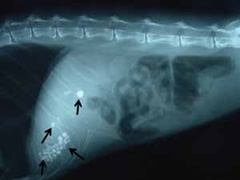
Source: https://www.acvs.org/sites/default/files/images/Extrahepatic%20Figure%201%20biliary%20calculi%20cat.jpg
Prognosis
Some biliary tract disorders, such as blocked bile ducts, are medical emergencies that must be treated immediately, usually with surgery. The prognosis is good if surgery and appropriate antibiotics are started early but is less favourable if diagnosis and treatment are delayed. The outcome for cats with bile peritonitis varies widely. If bacteria are present in the abdominal fluid (septic bile peritonitis), the prognosis is poor.
Owners should be prepared for possible complications or recurrences. After surgery, cats are at risk for recurrent bacterial infections of the biliary tract. Gallstones may become a chronic problem, and new stones may form even after surgery has been performed to remove the existing ones. In cases of trauma to the biliary tract, recovery depends on the nature and severity of the trauma. A ruptured biliary tract and/or subsequent peritonitis may complicate and prolong your cat’s recovery.
Treatment for biliary tract disorder in cats
If the cat’s condition is not critical, treatment may entail administering certain medications. For more serious conditions, hospitalisation will be required to stabilise the cat and prevent shock and dehydration, by intravenously restoring fluids and electrolyte balances. Surgery may be necessary, depending on the underlying cause of the disorder. It is important where bile duct inflammation is linked to diseases such as FeLV or FIP that the underlying disease is treated along with the inflammation.
Medical management options include:
- Antibiotics for treating bacterial infections or for preventing infection pre-surgery.
- Anti-inflammatory drugs, sometimes in conjunction with antibiotics, for treating inflammation caused by trauma.
- Medication to dissolve gallstones.
- Vitamin K1 if the cat is jaundiced.
- Vitamin E if liver enzymes are high or the liver and bile duct are inflamed.
- Dietary supplements to improve liver function and bile production.
Surgical options include:
- Cholecystectomy, the surgical removal of the gallbladder, may be recommended in cases of symptomatic gallstones and other serious conditions. Gallstones do not always cause inflammation or obstruction, but when they do, cholecystectomy is usually the preferred treatment.
- Choledochotomy is an incision into the bile duct, usually to remove a stone. Blocked bile ducts are a medical emergency that are usually treated surgically.
- Rupture of the gallbladder or bile duct will require surgical repair, which entails tying off the bile duct, removing the gallbladder, or attaching the gallbladder directly to the small intestine.
- When cancer is present, surgery can provide temporary relief but is usually not a cure.
Ongoing management:
- Physical examinations and blood, urine and stool tests may be required every two to four weeks, particularly post-surgery, until results are normal.
- Periodic ultrasound examinations to evaluate the ongoing functioning of the liver and bile system may be necessary.
- A fat-restricted, high protein diet may be prescribed permanently.
- Having access to fresh, clean water and remaining well-hydrated may help prevent bile duct blockages and inflammation.
- Owners will need to look out for sudden onset of fever, abdominal pain, weakness, or other signs that may indicate infection.
In summary
The biliary tract comprises the structures of the body that produce, store and secrete bile. Bile is a substance that assists with digestion and absorption of fats within the small intestine. It is produced in the liver, stored in the gall bladder and transported by the bile ducts. A number of biliary tract disorders can occur in cats, affecting any or all of these structures. Inflammation, obstruction and rupture can all affect the gallbladder and/or bile duct, sometimes with serious consequences.
Common symptoms of a biliary tract disorder include appetite changes, lethargy, jaundice, vomiting and abdominal pain. Causes of these disorders may be a bacterial infection, the presence of gallstones or an underlying disease. Diagnosis is based on laboratory tests and ultrasonography. Treatment options include removal of the gallbladder, other surgical options and /or medical therapy. The outcome for cats with biliary tract disorders varies widely, depending on the underlying cause, the promptness of diagnosis and treatment, and the presence of infection.
A pet insurance policy with Bow Wow Meow will help ensure you can always afford to give your pet the best treatment for biliary tract disorder, along with many other health conditions that affect cats.
-
Find out more about our pet insurance options for cats
-
Get an instant online pet insurance quote


More information
- https://www.petmd.com/cat/conditions/digestive/c_ct_cholecystitis_choledochitis
- https://wagwalking.com/cat/condition/bile-duct-inflammation
- https://www.msdvetmanual.com/cat-owners/digestive-disorders-of-cats/disorders-of-the-liver-and-gallbladder-in-cats
- https://www.petmd.com/cat/conditions/digestive/c_ct_cholelithiasis
- https://www.ncbi.nlm.nih.gov/pubmedhealth/PMH0072570/
- https://www.msdvetmanual.com/digestive-system/hepatic-disease-in-small-animals/feline-cholangitis-cholangiohepatitis-syndrome
- https://vcahospitals.com/know-your-pet/cholangitis-cholangiohepatitis-syndrome-in-cats
- https://wagwalking.com/cat/condition/bile-duct-obstruction
- https://wagwalking.com/cat/condition/gallbladder-inflammation
- https://wagwalking.com/cat/condition/gallstones
- https://www.acvs.org/small-animal/extrahepatic-biliary-tract-obstruction


